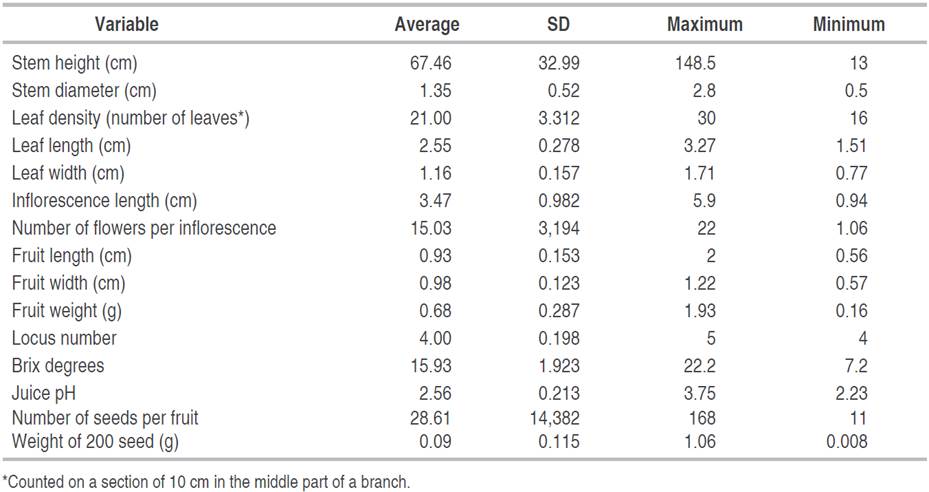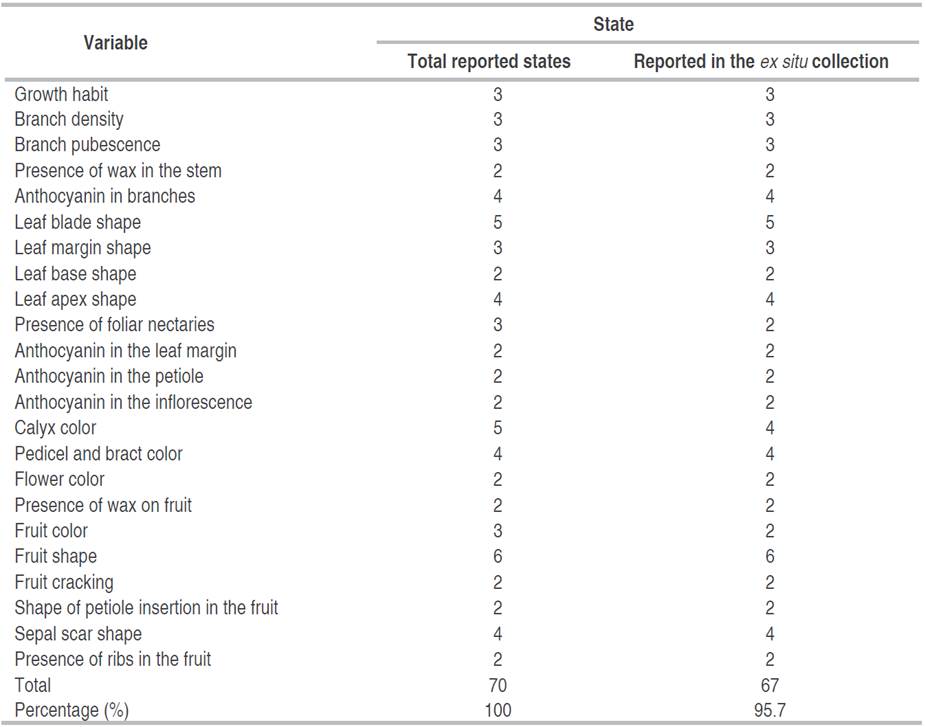Agraz, mortiño, vichachá and camueza in Spanish, or Andean blueberry in English, are common names of Vaccinium meridionale Swartz a berry plant that belongs to the family Ericaceae Juss., tribe Vaccinieae Rehb that includes about 35 genera and more than 1,000 species (Luteyn 2002). The species belongs to the Pyxothamnus section and includes other species such as V. consanguineum Klotzsch, V. floribundum Kunth, and V. puberulum Klotzsch (Ehlenfeldt and Luteyn 2021).
In the Neotropics, the Ericaceae family is concentrated in northwestern South America, typically in mountainous habitats with cold and humid areas, between 1,500 and 3,000 meters above sea level (masl). Species of this family are mainly found in Colombia, Ecuador, Peru, and Venezuela, where almost 50% of the species are epiphytic, and approximately 94% are endemic (Luteyn 2002). The Vaccinium genus has a wide geographical distribution, found in cold and temperate tropical zones with representation in most continents, except Antarctica (Luteyn 2002), Australia, and most parts of Africa (Vander-Kloet 1990). Most of the species grow in acidic and well-drained soils with high organic matter content, coastal dunes, lake, and river margins, abandoned fields, or mountain terrains (Lyrene et al. 2003).
V. meridionale is found predominantly in the coastal and Andean areas of Venezuela, on the Andes of Colombia, on the island of Jamaica and on the mountains of Peru. Its habitats include high mountain cloud forests to moor thickets between 1,000 and 2,800 masl (Ehlenfeldt and Luteyn 2021). In Colombia, according to the National Institute of Natural Sciences, the distribution of Vaccinium species includes the departments of Antioquia, Boyacá, Cauca, Chocó, Cundinamarca, Magdalena, Meta, Nariño, Norte de Santander, Putumayo, Quindío, Santander, and Tolima. The highest number of reports are found in Antioquia, Boyacá, and Cundinamarca. The latter has more records of V. floribundum, a closely related species, and Antioquia has the highest number of records for V. meridionale (Ligarreto 2009).
The first report of the species was found using the name "mortiño", described as a Castilian (Spain) word applied to plants of the genus Vaccinium, a name imposed by the Spanish in America. The first reference to the expression "mortiño" dates back to 1548, used in the Guaca region, the current province of Carchi, Ecuador, a town inhabited by the Pastos indigenous people (Patiño 2002).
V. meridionale produces a berry rich in flavonoids, mainly anthocyanins, with high antioxidant activity (Garzón et al. 2010), cardioprotective effect (Lopera et al. 2013) with ischemic lesions treatment potential (Shen et al. 2018), and antiproliferative activity (Agudelo et al. 2018), among others.
Genetic diversity is the heritable variations that occur in organisms, individuals, and between populations under more or less stable natural conditions. Population genetics and evolution study and conserve genetic diversity. Genetic variability is the basis of any breeding program, as it includes the diversity available for selection of sources for adaptation to different environments (Rimieri 2017).
Genetic resources are biological diversity are essential for the sustainable development of agriculture and to assure food security (Nass 2011). The International Treaty on Plant Genetic Resources for Food and Agriculture defines them as genetic material, whether propagated sexually or asexually, containing functional heredity units. Regardless of the genetic resources’ definitions, these are the basis of plant breeding and agricultural production (Fowler and Hodgkin 2004).
Within the activities of germplasm banks, an essential task is the description of the variability of a crop in both the phenotype and genotype of the accessions conserved. However, a list of characters, called descriptors, is required to carry out the characterization process. In 1976, the basis of such a system was created, which initiated the development and formulation of a list of descriptors that are the basis of internationally standardized documentation developed by specialists in each crop (Gotor et al. 2008).
Characterization and evaluation descriptors provide insight into the variability of a crop. Characterization refers to the recording of variables with high heritability and controlled by a single or very few genes; they should be easy to measure and allow differentiation and expression of the trait in a precise and uniform way. Evaluation depends on the environment and is controlled by several genes expressing yield, agronomic productivity, stress susceptibility, biochemical and cytological traits used in crop improvement (Romanciuc 2017).
Currently, there is no published descriptor for the species V. meridionale to allow for knowing and understanding its variability. Accordingly, this study aims to develop morphological descriptors for this species. This will enable the differentiation of the accessions included in a collection through specific attributes and obtain essential information that effectively allow of the domestication of this interesting plant genetic resource.
MATERIALS AND METHODS
For the construction of the preliminary version of the descriptor, the taxonomic keys of the genus Vaccinium and the description of the species V. meridionale presented by Sleumer (1941), Romero-Castañeda (1961), Berazaín-Iturralde (1991), Vander- Kloet (1996) and Luteyn (1998) were used.
A first list of proposed variables, developed by Agrosavia, was done in situ by Lopera (2005) in four to six plants per locality included in his study. Later Ligarreto et al. (2011), studied a total of 177 natural populations located in the departments of Antioquia, municipalities of Belmira (30), Don Matías (8 populations), El Retiro (1), Entrerrios (8), Guarne (9), La Ceja (1), Medellín, Corregimiento de Santa Helena (23), Rionegro (1), San Jerónimo (2), San José de la Montaña (11), San Pedro de los Milagros (4), Santa Rosa de Osos (41), and Yarumal (9). In Boyacá, the municipalities of Chiquinquirá (4), Ráquira (5) and Tinjaca (4) were visited, and in Cundinamarca, only the municipality of Guachetá (2). In Nariño, the municipalities of Buesaco (1) and Pasto (2), and in Santander, the municipality of California (11) were visited (Medina et al. 2009).
Subsequently, a modified version was applied in the previous process (Lopera 2005), also including the variables and states found in the natural populations of 102 accessions of the V. meridionale. Germplasm collection established in the Research Center "La Selva" of Agrosavia, located in Rionegro, Antioquia. The area is located at 06°08'06'' N and 75°25'03'' W at 2,120 masl, where the average temperature was 17 °C, average relative humidity of 78%, and photosynthetically active radiation (PAR) of 357Watts m−2.
RESULTS AND DISCUSSION
Descriptor
A descriptor for V. meridionale was developed with 38 quantitative, binary, and multistate variables, of which seven were obtained at the plant level, 10 from the leaf, six from the flower, 14 from the fruit, and one from the seed (Table 1). This descriptor had variables with taxonomic and agronomic importance, vital for production and marketing.
Qualitative variables
Five qualitative variables were included in the stem level descriptor; seven were selected for the leaf, four for the inflorescence and flower, and eight for the fruit, for a total of 24 variables (Table 1). In the ex situ characterization of 102 materials carried out with the final proposal of the descriptor, polymorphism in 24 qualitative traits were found, with the presence of 67 states out of the 70 included in the list of the descriptors for the species (95.7%) (Table 2). This result indicates a broad morphological variability related to attributes of this nature. The only states not observed in this characterization were large foliar nectaries found only in one specimen deposited in the "Josep Cuatrecasas y Arumí" herbarium of Universidad Nacional de Colombia - Palmira Headquarters. The color of its calyx is red-wine, and the color of the fruit is blue.
In the in situ characterizations carried out in Antioquia in natural populations and plants that had already started their reproductive stage, broad qualitative variability was found, recording 46 out of the 48 states described (Medina et al. 2009) but not reporting blue-colored fruits. In the departments of Cundinamarca, Boyacá, Nariño, and Santander, 20 natural populations were characterized in situ, with 17 qualitative variables included in the descriptor, but not finding the following states: absence of stem pubescence (branches), light and dark green colors in the calyx, light and dark green colors in the pedicel and bracteole, and a blue fruit color (Ligarreto et al. 2011).
The blue color of the berries, not observed at the in situ characterizations, is reported for some species of Vaccinium, giving the plant the name "blueberry". For the specie V. meridionale, the colors of the mature fruit range from purplish and purple to dark purple, violet, and black (Buitrago-Guacaneme et al. 2015).
Various authors report that the corolla is reddish-white or pink (Romero-Castañeda 1961), and research carried out in Guachetá (Cundinamarca) and San Miguel de Sema (Boyacá) indicates that the flowers have a white or light to intense pink color (Chamorro and Nates-Parra 2015).
Quantitative variables
14 quantitative variables were included as follows: two from the entire plant, three from the leaf, two from the flower, six from the fruit, and one from the seed (Table 3). In the ex situ characterization of the 102 accessions, the variability between individuals for these types of attributes was evident without a defined grouping pattern between subregions from which the populations were collected or at the intrapopulation level.
Table 3 List of quantitative variables and their measurement units, average, standard deviation (SD), and maximum and minimum values included in the descriptor and used in the ex situ characterization.

On the other hand, the ex situ quantitative variability indicated the presence of 278 out of 280 total plants, i.e., 99% of the plants, with a distance between them or differences due to quantitative genes. Applying the proportion criterion of "different clones" of Persson and Gustavsson (2001), the value obtained was 0.99. It should be noted that, in the case of quantitative expressions, these were recorded in a common planting site with homogeneous traits and with similar management practices, removing, to a high degree, the environmental effect, as it is a response to a common locality with similar cultural management.
For the quantitative variables included in the descriptor, various authors report variability in the number of flowers per raceme (between 10-15 flowers) in mortiño or agraz populations (Romero-Castañeda 1961). In works carried out in natural populations in Guachetá (Cundinamarca) and San Miguel de Sema (Boyacá), the inflorescences measure 7.2±0.5 mm long, with 12±3 flowers per raceme (Chamorro and Nates-Parra 2015). Fruit weight and other fruit dimensions varied according to the pollination treatments evaluated and the location (Chamorro and Nates-Parra 2015). The equatorial diameter of agraz fruits ranges between 6 and 20 mm. The average fresh weight of 1.60 g, and the number of seeds per fruit ranges between 15 and 37 depending on fruit size (Magnitskiy and Ligarreto 2009). Agraz fruits harvested in Cundinamarca have about 14.13 °Brix of total soluble solids (Ávila-Rodríguez et al. 2007), and other authors report Brix degrees for fruits harvested in Antioquia between 12.6 and 15.2 and pH between 2.2 and 2.7 (Gaviria et al. 2009).
Quantitative diversity shows an adaptive potential that could favor its use to combine attributes and cope with variations in potential planting environments in relation to global climate change and the diverse sites where natural populations were found. The conservation and maintenance of adequate quantitative variability is the basis for coping with environmental changes that may occur (Kramer and Havens 2009).
CONCLUSIONS
The importance of this descriptor lies in the fact that the scientific community can research with a standardized characterization protocol that favors the use and exchange of information on the species, which allows working with similar data between national and international institutions.
The descriptor proposed indicated that the species has variability that must be evaluated in any work carried out with the species.

















